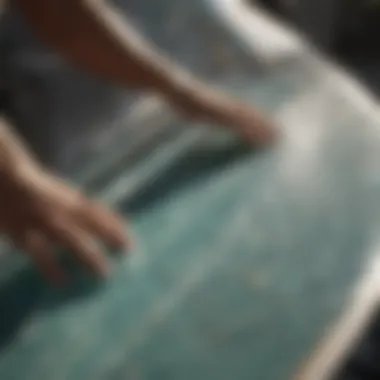Essential Guide to Surfboard Repair Kits for Enthusiasts


Intro
Surfing is not just a sport; it is a lifestyle and a passion for many. Keeping your surfboard in good condition is essential to enjoying this exhilarating experience. Surfboard repair kits play a crucial role in maintaining the performance and longevity of these boards. This article aims to dissect the components, uses, and advantages of these kits. Understanding how to repair surfboards is vital for both beginners and seasoned surfers. This knowledge not only enhances your surfing but also provides peace of mind when issues arise.
The History of the Sport
Origin and Evolution
Surfing traces its roots back to ancient Polynesian cultures, where it was not merely a recreational activity but an integral part of their societal fabric. The first documented evidence of surfing dates back to the late 17th century, describing skilled locals riding waves on wooden planks. Over the years, surfing evolved, influenced by cultural exchanges and advances in materials and technology.
Milestones and Influences
The 20th century marked a significant turning point. With the introduction of lighter materials, surfboards became easier to maneuver. In the 1950s and 1960s, surfing gained mainstream popularity. Movies, magazine articles, and television shows introduced the world to the thrills of catching waves. Surf competitions emerged, bringing athletes into the limelight and propelling the sport into a global phenomenon.
Key Athletes and Pioneers
Several athletes have left indelible marks on surfing. Figures like Duke Kahanamoku are celebrated not only for their athletic prowess but also for their contributions to promoting the sport worldwide. Others like Kelly Slater have pushed the boundaries of what is possible on a surfboard. Their influence extends beyond competitions; they inspire new generations of surfers, urging them to explore new frontiers in surfing.
Components of Surfboard Repair Kits
A surfboard repair kit typically contains essential items to fix common damages. Understanding these components is crucial for effective repairs. Here are the main parts:
- Epoxy resin: Essential for filling in cracks or holes.
- Fiberglass cloth: Used to reinforce the repair and provide structural integrity.
- Mixing tools: For combining resin and hardener.
- Sandpaper: Helps smooth the repaired area after curing.
- Masking tape: Protects non-damaged areas during repair.
- Instructions: Guidelines for proper use of the kit.
Techniques and Skills
Basic Techniques for Beginners
New surfers often face challenges regarding board maintenance. Learning basic repair techniques can be beneficial. Start with small issues like fixing dings or minor cracks. Ensure the surface is clean and dry before applying resin. Follow the instructions carefully to achieve the best results.
Advanced Skills to Acquire
For the more experienced, mastering advanced techniques can help tackle bigger damages, such as restoring a board with multiple cracks. This often involves understanding how to work with fiberglass and ensuring a seamless finish. With practice, surfers can develop the confidence required to handle complex repairs.
Common Mistakes and How to Avoid Them
Many beginners rush through repairs, leading to further issues down the line. It is crucial to take your time, allowing each layer of resin to cure fully before proceeding. Always follow the manufacturer's instructions closely. Failure to do so could result in a weak repair that may not hold up in water.
Safety Measures
Essential Safety Gear
When working with repair kits, safety is paramount. Equip yourself with:
- Gloves: Protect your skin from chemicals.
- Masks: Prevent inhalation of potentially harmful fumes.
- Goggles: Guard against splashes during application.
Safety Practices and Procedures
Work in a well-ventilated area to minimize exposure to fumes. Adhere to all instructions provided with the repair kit. Ensure that any tools used are clean and in proper working order to avoid accidents.
How to Prepare for Unexpected Situations
Surf conditions can change rapidly. Always assess your board before hitting the waves. If you notice a problem, take the time to repair it as soon as possible. Carry a small repair kit on your trips. Being prepared can save your surfing day from turning sour.
Finale
Understanding the history, components, and techniques surrounding surfboard repair kits is vital for anyone involved in surfing. Knowledge equips surfers to handle damage confidently and effectively. Good maintenance not only ensures a better surfing experience but also prolongs the lifespan of the surfboard. As you delve further into this guide, you will learn to navigate repairs with skill, enhancing your overall journey in this thrilling sport.


Prolusion to Surfboard Repair Kits
Surfboards are essential tools for anyone who loves riding ocean waves. They enable surfers to connect with nature, but like any sporting equipment, they require proper maintenance. This section will explain the importance of surfboard repair kits and why they are vital for all surfers.
Importance of Surfboard Maintenance
Proper surfboard maintenance is crucial to ensure long-lasting performance. Regular checks can prevent small issues from escalating into significant problems. Maintaining the surfboard can enhance its durability, allowing surfers to enjoy their time on the water without interruptions.
A well-maintained surfboard also contributes to better performance. Small damages can affect the board's balance and speed. Keeping every component in good shape ensures that surfers can maximize their capabilities in the water. Additionally, investing time in maintenance reduces future repair costs. A timely fix can save expenses in the long run, making it a wise financial decision.
Surfers often feel a personal connection to their boards. Each board can tell a story and carry memories of countless adventures. Maintaining its condition adds to this emotional investment. The right surfboard repair kit helps preserve these experiences, ensuring the board remains in great shape.
Overview of Common Surfboard Damages
Several types of damage are common among surfboards. Knowing these can help surfers save time and resources.
- Dings: Small indentations often occur when a surfboard bumps against hard objects, like rocks or other boards.
- Cracks: These can vary in size and may compromise the surfboard's structure. They can happen due to pressure or impact.
- Delamination: This occurs when the layers of the surfboard separate, usually due to water intrusion.
- Soft spots: This refers to areas where the foam core has become compromised, often from prolonged exposure to water.
Understanding these types of damages allows surfers to respond appropriately. Some issues can be fixed easily at home with the right repair kits, while others may require professional assistance. Identifying damage early plays a vital role in deciding the best course of action.
Overall, these insights into maintenance and damage underscore the necessity of surfboard repair kits. They allow surfers to maintain their boards, experience better performance, and save costs over time.
Components of a Surfboard Repair Kit
A surfboard repair kit is essential for anyone who regularly surfs. It provides the necessary tools and materials to address damage effectively, allowing surf enthusiasts to maintain their equipment in optimal condition. Understanding the components of a repair kit helps surfers to select the right products suitable for their needs. By knowing what tools and materials are included in a repair kit, users can ensure they are prepared for common surfboard damages.
Essential Tools and Materials
In a good surfboard repair kit, the tools and materials can make a difference between a successful repair and a failed attempt. The basic essentials include:
- Epoxy resin: This is a versatile adhesive that bonds well with many surfboard materials. It is crucial for filling in cracks and dings.
- Fiberglass cloth: Used to reinforce repairs, fiberglass provides strength and durability to the patched areas.
- Mixing tools: Surfers need tools to mix the resin efficiently. This can include sticks, cups, or even old containers.
- Brushes or applicators: For applying resin evenly to the damaged area, brushes in various sizes are vital. This ensures a smooth finish.
Without these components, repairing damage can become time-consuming and frustrating. Thus, having a kit with these essentials on hand is an investment in a surfer's overall experience.
Types of Epoxy and Resin
Choosing the right epoxy or resin is critical for successful repairs. There are several types available, and each serves different purposes:
- Standard epoxy: This is the most common type for surfboards. It is suitable for many repairs and is relatively easy to work with.
- Polyester resin: Often cheaper, this resin is not as strong as epoxy. It can work well for minor repairs, but the durability may be a concern.
- UV-resistant epoxy: This type cures faster and is ideal for outdoor conditions. It’s particularly useful for quick fixes while on the beach.
Selecting the right type of epoxy or resin for the job can greatly affect the quality and longevity of the repair. Surfers should consider the specific needs of their surfboards when making this choice.
Sandpaper and Finishing Tools
After applying resin, surfboard repairs require sanding to achieve a smooth finish. Different grits of sandpaper will be needed throughout the process:
- Coarse grit (60-80): Used for initial shaping and removing excess material after the resin cures.
- Medium grit (120-220): Ideal for smoothing out any rough spots created during the coarse sanding process.
- Fine grit (320 and above): This is used for final touches before painting or glossing. It ensures a polished surface that is ready for water.
Additionally, having finishing tools like a small file or a sponge can enhance the repair's aesthetics. Proper sanding not only improves the appearance but also ensures optimal performance while surfing.
Remember: A well-maintained surfboard not only looks better but also performs better on the waves.
Having an effective repair kit with all these components prepares surfers to tackle a wide array of damage. By following these guidelines, surfers can keep their boards in prime condition, ready for their next adventure.
Selecting the Right Repair Kit
Choosing the correct surfboard repair kit is vital for both maintaining the integrity of your board and enhancing your overall surfing experience. The right kit can mean the difference between a quick fix and a long-lasting repair, saving you time and money in the long run. It is essential to understand your specific needs and examine the various options available in the market.
When selecting a repair kit, consider the types of damages you commonly encounter. Surfboards can suffer dings, cracks, and even more severe structural issues. Each damage type may require different materials or methods for effective repair. Additionally, your skill level plays a crucial role in determining the complexity of the kit you should choose.


Assessing Individual Needs
Before making a purchase, assess what you need based on several factors:
- Surfboard Material: Different boards, such as those made of epoxy or polyurethane, require different repair methods. Ensure the kit is compatible with your board's material.
- Type of Damage: Consider what has worked well for you in previous repairs and the most common issues you encounter. If you primarily get small dings, a simple repair kit will suffice. For more severe damage, look for kits that provide more comprehensive solutions.
- Skill Level: If you are a novice, you may want a kit with detailed instructions and all necessary materials. More experienced surfers might prefer a kit with advanced options.
By taking the time to assess your individual needs, you can avoid purchasing a kit that falls short of your requirements.
Evaluating Quality vs.
Cost The relationship between quality and cost is always an important consideration when selecting a repair kit. It can be appealing to opt for a low-cost kit, but this can lead to poor repairs that don’t hold up over time. Here are some points to keep in mind:
- Durability: Quality repair kits often include better materials that provide lasting results. Look for epoxy formulations that have proven their effectiveness over time.
- Comprehensiveness: High-quality kits usually come with various tools and instructions suited for different repair scenarios, offering more value for the money spent.
- User Reviews: Check online sources such as forums or retail sites for user feedback on both the effectiveness and durability of the kits. Personal experiences often highlight unseen issues or advantages.
Remember, investing slightly more in a repair kit can save you money down the line. As repairs are often not convenient, having the right kit will enable surf enthusiasts to address issues effectively.
In the end, the right repair kit will not only empower you to enhance the longevity of your surfboard but will also give you confidence to tackle repair issues as they arise.
Step-by-Step Repair Process
The step-by-step repair process is essential for anyone looking to maintain their surfboard effectively. Understanding how to properly repair damage not only prolongs the lifespan of the board, it also ensures safety while surfing. The approach encourages a systematic method to tackle repairs, which can significantly enhance the surfer's experience. This section will detail the vital steps, emphasizing both their importance and specific considerations associated with each phase.
Preparing the Damaged Area
Preparation is fundamental when starting the repair process. This step requires careful assessment of the damage on the surfboard. To begin, you should clean the damaged area thoroughly, removing any debris, dirt, or wax. A clean surface ensures that the repair materials adhere properly. It’s advisable to use a soft cloth along with some water and mild soap.
Next, inspect the extent of the damage. If the dent is deep, it may require further attention. For cracks, ensure to examine if they penetrate through to the foam core. It’s beneficial to take a few minutes and document the damage, making note of specific areas that require more attention. This clarity makes the entire repair process smoother.
“A well-prepared surface saves time and resources in the repair process.”
Applying Epoxy and Fiberglass
Once the damaged area is clean and prepped, the next step is applying the epoxy and fiberglass. This part is critical, as these materials provide strength and resilience to the repair. First, mix the epoxy resin according to the manufacturer’s instructions. Consistency matters, so ensure that you achieve a suitable mix.
Following this, layer fiberglass cloth over the crack or ding. It’s recommended to use small pieces at a time, working your way to cover the entire damaged surface. Carefully apply the mixed epoxy over the cloth, ensuring it penetrates the fibers and adheres well. Use a clean spatula for smooth application.
Allow the epoxy to cure as per the instructions provided, ensuring proper ventilation in your workspace during this stage. Proper curing time is crucial, so don’t rush this step.
Sanding and Finishing Touches
After the epoxy has fully cured, it’s time to sand and finish the repair. This part is vital for achieving a seamless look and feel to your surfboard. Start with coarse sandpaper to level any raised areas, transitioning to finer grits as you progress. The aim is to create a smooth surface that resembles the original body of the board.
Inspect the area frequently while sanding to avoid removing too much material. Once satisfied, clean the surface once again, ensuring no dust particles remain.
Finally, you might want to add a light polish or a coat of wax for additional protection and shine. This final touch not only improves aesthetics but also provides a layer of scuff protection.
In summary, the step-by-step process for repairing surfboards emphasizes preparation, effective use of materials, and finishing. Each of these parts plays a crucial role in restoring the board’s performance and lifespan.
Safety Measures During Repairs
When engaging in surfboard repairs, prioritizing safety is paramount. The process involves chemical materials, tools, and elements that may pose risks if not handled correctly. Adopting safety measures not only protects the individual conducting the repairs but also ensures the longevity and integrity of the surfboard itself. Proper precautions can prevent accidents and exposure to toxic substances. Thus, understanding safety measures enhances the overall repair experience.
Protective Gear Recommendations
Using appropriate protective gear is vital during surfboard repairs. This includes:
- Gloves: Nitrile gloves offer a good barrier against chemicals. They safeguard hands from irritation and allergic reactions while handling epoxy or resin.
- Safety Goggles: Eye protection is crucial to prevent harmful substances from splashing into the eyes. Choose goggles that fit snugly and provide a clear view.
- Dust Masks: A dust mask can limit inhalation of fine particles generated during sanding. Look for masks rated for fine particulate filtering to ensure effective protection.
- Coveralls or Old Clothing: Wearing old clothes or coveralls can help protect your skin and garments from potential chemical spills or resin splatters.
Overall, wearing the right protective gear can significantly reduce the risk of injury during surfboard repairs.


Ventilation and Workspace Setup
Setting up a safe workspace is just as crucial as wearing protective gear. Adequate ventilation minimizes exposure to harmful fumes emitted by resin and other materials. Follow these tips for optimal workspace setup:
- Open Windows: If possible, work in a room with windows that can be opened to allow fresh air to circulate. Fresh air helps dilute any toxic vapors.
- Fans: Utilizing fans can boost airflow and push hazardous fumes away from the work area. Position fans to direct airflow outside if working indoors.
- Dedicated Workspace: Having a specific area for surfboard repairs keeps toxic materials contained. Avoid working in areas close to food or personal items.
- Protect Surroundings: Use drop cloths, newspapers, or old sheets to protect the work surface from spills.
Creating a well-ventilated and organized workspace ensures safety while enhancing the efficiency of the repair process.
A safe environment is essential for effective surfboard repairs. Always plan ahead and prepare adequately.
When to Seek Professional Repair Services
Deciding when to seek professional repair services for your surfboard is an important aspect of overall surfboard maintenance. It is vital to understand that not all damages are suited for DIY repairs. Sometimes, the severity of the damage requires expert intervention. Seeking out professional services provides several benefits, including ensuring quality repairs, reducing risks of further damage, and extending the life of your surfboard.
Understanding Severe Damage
Severe damage can manifest in various ways, including deep cracks, significant delamination, or broken fins. These issues often compromise the structural integrity of the board and might affect performance in the water. If you notice widespread cracks or if the foam core becomes exposed, it is wise to consult a professional. Furthermore, if water leakage is involved, immediate action is necessary to prevent internal damage. Professional repair services often have access to advanced materials and techniques that ensure a safer, more effective fix, which is crucial for maintaining optimal surfing performance.
Analyzing Cost vs.
DIY Efforts
Cost is a significant consideration when it comes to repairs. While DIY efforts can save money, they come with risks. An improper repair might lead to more expensive problems later. Evaluate the expected cost of repairs against the potential market value of the surfboard. If the repair exceeds what you may spend on a quality replacement, professional attention may be warranted.
Moreover, consider your comfort level with repairs. If you have limited experience, professional repairs might give you confidence that the board's integrity is reset. In some cases, you might find it necessary to balance the immediate costs against the long-term durability of the board. Knowing when to invest in professional help is crucial for both your board's longevity and your experience in the water overall.
Maintenance Tips for Prolonged Surfboard Life
Proper maintenance of a surfboard is essential to extend its lifespan and ensure optimal performance. Regular attention to small details can prevent bigger issues from arising. By dedicating time to maintenance, surfers can save money and enjoy a better experience in the water.
Regular Inspections and Cleaning
Regular inspections should be an integral part of surfboard care. A simple examination can help identify early signs of damage, such as dents, cracks, or discoloration in the finish. Finding these issues early can prevent them from worsening and requiring more extensive repairs.
After every session, it is crucial to rinse the surfboard with fresh water to remove salt and sand. Salt can corrode hardware and weaken materials over time. Additionally, using a soft cloth to wipe down the board can keep the surface clean and free from contaminants.
When cleaning, avoid harsh chemicals as they can damage the board’s surface. A gentle soap solution is usually sufficient. Regular attention to these practices can drastically improve the longevity of your surfboard.
Proper Storage Techniques
How a surfboard is stored can significantly affect its lifespan. UV rays can cause fading and degradation of the surfboard's materials, particularly if it has a fiberglass finish. Therefore, it is advisable to store the board in a bag or a shaded area.
In addition, avoiding pressure on the board during storage is critical. Do not stack multiple boards on top of each other without protection. Using wall racks or padded storage solutions can help avoid unwanted pressure and scratches.
For long-term storage, consider storing the surfboard in a climate-controlled environment. Extreme temperature changes can also impact the integrity of the materials. Taking these steps ensures your surfboard remains in top condition and ready for the next adventure.
"Investing time in maintenance not only benefits the surfboard but also enhances the overall surfing experience."
By implementing regular inspections and proper storage techniques, surfers can prolong the life of their boards while maintaining performance standards. Simple yet effective practices can make a significant difference over time.
The End
In closing, surfboard repair kits are indispensable for anyone serious about surfing. By equipping oneself with proper tools and knowledge, one can significantly extend the life of a surfboard and enhance the overall surfing experience. This article discussed key aspects such as the components of repair kits, the effectiveness of DIY repairs, and important maintenance practices.
Recap of Key Insights
- Importance of Regular Maintenance: Regular checks and prompt repairs can avoid larger issues later. A stitch in time saves nine, especially in surfing.
- Components to Look For: Understanding the essential tools, including epoxy, resin, and sanding materials, forms a solid foundation for effective repairs.
- DIY vs. Professional Repairs: Knowing when to take matters into your own hands or seek professional help can save both time and money. DIY efforts can be beneficial for minor damages, while severe cases may require expert attention.
Encouragement for DIY Efforts
Engaging in DIY repairs promotes a deeper connection to the sport. The hands-on experience of fixing a beloved surfboard cultivates skills and confidence. For those hesitant to begin, remember:
- Start Small: Begin with minor damages. As you get more comfortable, you can tackle more significant issues.
- Resources Are Available: Many online resources, including forums like Reddit and detailed articles, can provide valuable guidance.
- Mistakes Are Part of Learning: Do not fear making errors. Each misstep is a chance to learn and grow in your repair abilities.
Remember: The more you engage in maintenance and repairs, the more competent and confident you will become.







